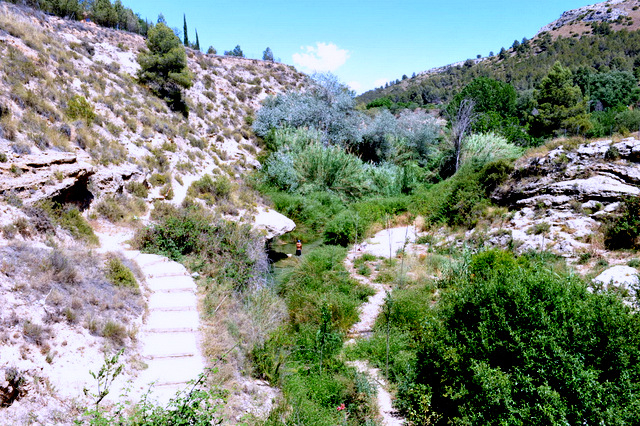The Salto del Usero in Bullas
The Bullas waterfall and rock pools offer an inland bathing alternative in the north-west of the Murcia Region
The Salto del Usero is one of the most widely enjoyed natural beauty spots in the Region of Murcia, and during the summer is used as an inland beach by many of those who live in the municipality of Bullas and the surrounding area.
The Salto is a spot just outside the town of Bullas where the cold water of the natural springs which join together to form the River Mula drops from the travertine landscape into two large pools, having eroded a small but spectacular natural gorge over a period of millions of years in the area known as El Molinar. Apart from providing welcome relief during the hot summer months it is a popular destination for walkers and other visitors throughout the year, although the largest crowds always gather on the night of 23rd June for the “Bajada de la Mora”, a ceremony which has been held for at least 225 years and which recreates the legend of a Moorish princess who threw herself into the river when her Christian lover failed to arrive at a secret tryst.

The origins of the name of this spot are uncertain: the “salto” (or leap) may refer to the water as it shoots out from the rocks into the pools below, to the Moorish princess’ lovelorn dive centuries ago or from the visitors who jump into the water from the rocks, despite signs which warn of the dangers of doing so.
As for “Usero”, there is no listed meaning for this word, but the alternative spelling “husero” apparently refers to the straight antler on the head of a one-year-old deer. The reasons for the name have clearly died out over the centuries!
Geography and geology
This is not actually the source of the River Mula, although as the water cascades out of the rock face on the northern side of the Monte Castellar it would be easy to imagine that it is. The river actually begins a few kilometres upstream in a collection of small streams in the mountains of Bullas and Cehegín, and flows through El Molinar on its way to Alguazas, where it joins the River Segura.
After emerging at the Salto del Usero the River Mula then becomes almost lost in the undergrowth, reappearing in various streams and pools and supplying the reservoir of La Cierva which lies alongside the RM-15 motorway between Bullas and Mula.
The Salto has been awarded Site of Geological Interest status on account of the travertines which have been sculpted by the river over the course of the millennia. During dry times in the most recent period of geological history the river has eroded the limestone sedimentary rocks which were formed during wetter periods, cutting a path through the rocks while at the same time effectively separating them into large blocks.

The water
The water in the Salto del Usero is cold and generally appears to be a strong aqua shade in colour due to the vegetation in the area and bright reflection from the rock.
Bathers tend to gradually acclimatise their bodies to the water by splashing in the shallows and working towards the deeper pools. It's not advisable to jump straight into the deeper water as it really is icy.
Over the centuries the demand for irrigation water has risen, and as a result some of the springs, wells and streams which supplied the River Mula have been over-exploited and are now dry. Some of the flow in the river comes from the water extracted from wells upstream and used for irrigation purposes, especially at night and during the weekends, when it is cheaper for farmers, and as a result at these times the flow rate increases and the Salto del Usero can be seen at its best.

Walking in the area of the Salto del Usero
For visitors who wish to explore the surrounding countryside, the Salto del Usero is a good starting point for a couple of interesting routes which afford splendid views of the north-west of Murcia.
One of these routes involves a tough climb up to the Piedro del Castellar, 993 metres above sea level and some 400 metres above the town of Bullas. This route is 6.5 kilometres long and the reward is views over a large part of the Region of Murcia, as well as a chance to see the remains of the 11th century castle from which the princess in the Bajada de la Mora legend is said to have emerged on the might she met her doom.
Alternatively, less ambitious walkers might prefer to follow the course of the River Mula and visit the series of pools which mark its progress towards the Segura. This path runs downstream from the Salto, and in spring is made even more attractive by the blossoming fruit trees in the fields alongside. Two flour mills lie on the route, one of them (the Molino de Arriba) dating back to at least 1684, and both have been refurbished as rural tourist accommodation.
Bullas is also on the Vía Verde del Noroeste, a 78-kilometre route which roughly follows the path of the old railway line between the city of Murcia and Caravaca de la Cruz, although the Salto del Usero itself is off the beaten track of the Vía Verde.

Practical considerations
The Salto del Usero in Bullas is rightly regarded as being one of the most attractive bathing locations in the Region of Murcia, but there are some practical considerations of which visitors need to be aware.
The first of these is that it’s not very big. This means that in summer, when the water remains very cold while the air temperature can soar into the forties, it is extremely popular and the two pools where diving, bathing and swimming are possible can become very crowded.
During the summer visitor numbers are generally limited to avoid dangerous over-crowding, so arrive late in the morning and you may well be disappointed.
The second point to bear in mind is that parking is not allowed at the Salto itself, and although a dip in the water might be refreshing the likelihood is that by the time visitors have walked back up to the car they will need another one! See below for parking details.
Visitors are advised to be aware of the risk of falls in and around the pools, and are urged to respect the geological formations and the flora and fauna at all times.Although many young people do jump from the rocks, this is frowned upon as it can be dangerous for both jumpers, and anyone in the pool below when they land.
An alternative (and easier to reach) location for swimmers is the municipal pool at the La Rafa campsite, just a stone’s throw away as the crow flies but accessed by road from the town itself. This is a good fall-back if you arrive late and there is no space at the Salto, but bear in mind that it is only open during the summer months.
It's also extremely hot and bright down in the bowl of the Salto, and carrying water is essential. The light coloured rock reflects the heat and light and sunglasses are obligatory as it's very bright.
It's also quite a drop down into the salto and there are steep steps and uneven rocks to navigate, so wear sensible shoes and don't attempt to visit this spot if you ahve any mobility issues or find steps difficult.

Information and directions
The Salto del Usero is approximately 1.5 kilometres to the south of the town of Bullas, and is reached by heading out of town on the Calle del Río. As soon as the built-up area ends there is left fork which is the continuation of Calle del Río (the Salto del Usero is signposted), and after just over half a kilometre off-road parking is provided on the right-hand side of the road. Click Salto del Usero Bullas for map details.
From here, visitors should be warned that it is a fair walk to the Salto itself. At first the impression is that the car park is a hoax, as there are no visible signs that a beautiful gorge is just around the corner, but after couple of hundred metres a sign prohibiting the entry of motor vehicles confirms that you are on the right track. Shortly afterwards the road curves round to the right and performs a semi-circular loop down the hill into the valley, where a couple of cars might actually be parked although there is very little space for them to do so and the Policía Local frequently drive past to move them on. Parking here is strictly limited to dropping off and picking up, and should be avoided.
Click here for more information about the Bullas municipality including wine route
Oficina de turismo de Bullas
The Tourist information office of the municipality of Bullas is located in the same building as the Museo del  Vino, the Wine Museum, assisting in the promotion of the natural tourism of the area and specifically the wine produced in the area.
Vino, the Wine Museum, assisting in the promotion of the natural tourism of the area and specifically the wine produced in the area.
The Museo del Vino is a good place to start if you’re interested in visiting any of the Bullas Bodegas or sampling the DO Bullas wines.
D.O. Bullas wines are produced across an area of 5,500 hectares integrating 8 municipalities into the production of wine( Bullas, Cehegín, Mula, Pliego, Ricote, Calasparra, Caravaca, Moratalla and Lorca. The town achieved the D.O status (Denominación de Origen "Bullas",) in 1994.
The predominant grape variety is Monastrell, accounting for 80% of the total production of around 10 million litres per year, other varieties including Tempranillo, Macabeo, Airén, Cabernet Sauvignon, Sirah, Merlot and Garnacha.
 The Museum of wine, (El Museo del Vino) is dedicated to the history of the production of D.O. Bullas wines, and also the techniques of winemaking. The museum runs a number of cultural activities throughout the year and exhibitions.
The Museum of wine, (El Museo del Vino) is dedicated to the history of the production of D.O. Bullas wines, and also the techniques of winemaking. The museum runs a number of cultural activities throughout the year and exhibitions.
The Bullas tourist information office has maps, and information about the various Bodegas which sell directly to the public and can also help with local accommodation or restaurants.
Opening hours for Bullas Tourist information office:
Tuesday to Saturday 10.30am to 2pm; Closed Mondays
On the first Sunday of the month at the El Zacatín market, from 9am to 2pm
For more information about Bullas, go to the dedicated Bullas section, located at the bottom of every article page of the site, accessed via the map box.  There is also daily information about the North-west area in the North-west Murcia section, which has daily news , what'son and general community information for the whole of the North-west area, also accessed via the map box, or the header at the top of the page. Select North-west Murcia.
There is also daily information about the North-west area in the North-west Murcia section, which has daily news , what'son and general community information for the whole of the North-west area, also accessed via the map box, or the header at the top of the page. Select North-west Murcia.
Click for map, Bullas Tourist Office







































